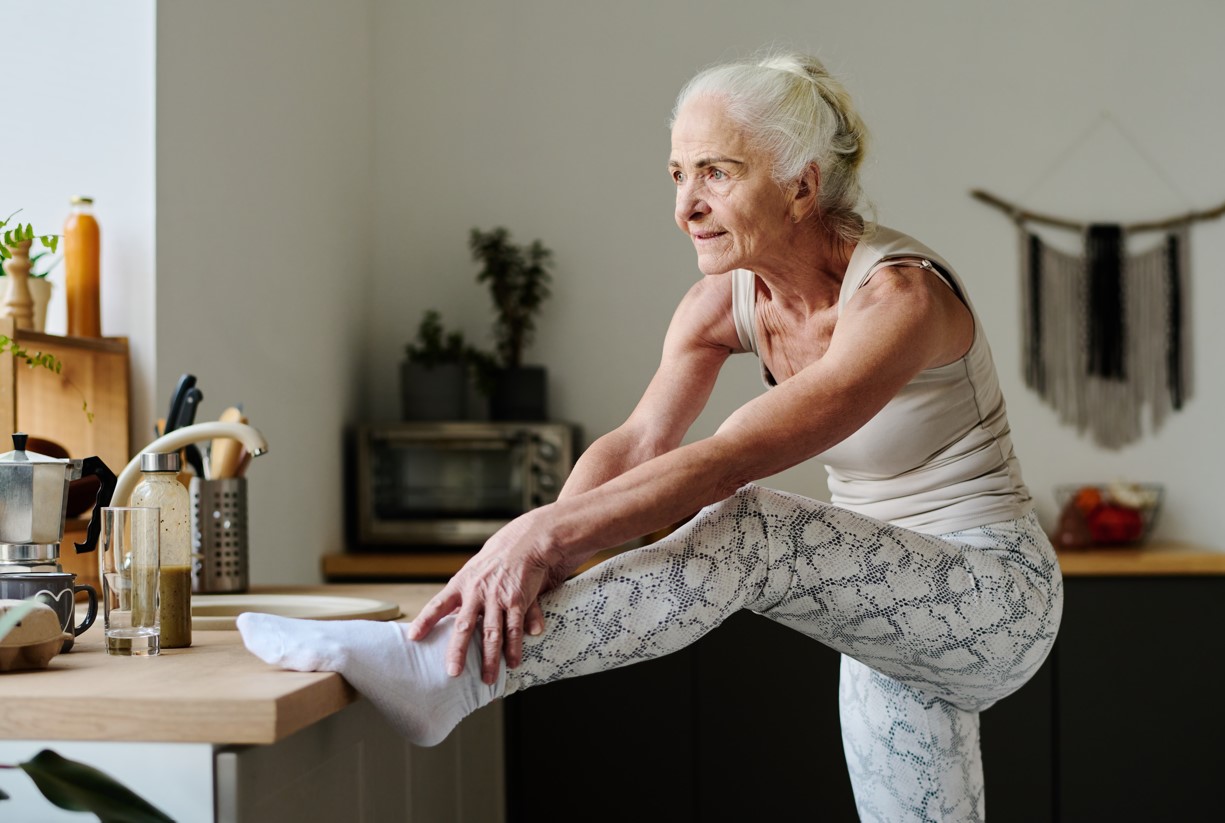Discover how stretching can boost mental clarity, relieve stress, and enhance mobility in your golden years.
Think about it:
- Reduced Tension: Imagine letting go of that tightness in your shoulders that’s been nagging you for weeks.
- Increased Calm: Picture yourself feeling more relaxed and at ease, just from a few simple stretches.
- Improved Balance: What if you could move with more confidence, less afraid of losing your footing?
But there’s more. Stretching also benefits your brain:
- Enhanced Mental Clarity: Stretching increases blood flow, not just to your muscles, but also to your brain, helping you think more clearly and stay sharp.
- Mood Boost: Those few moments of stretching can release endorphins, the brain’s natural feel-good chemicals, lifting your mood and reducing feelings of anxiety or depression.
- Stress Relief: Stretching helps calm the nervous system, which can reduce stress levels and make it easier to face challenges with a clear, focused mind.
Stretching does more than just improve physical mobility; it directly impacts your mental clarity and emotional resilience. It’s about reclaiming control over your body and mind, step by gentle step. Let’s explore how these small movements can lead to big changes in how you feel every day.

Ready to Move Like You Used To? The Power of Stretching for Your Body
As we age, it’s common to feel like our bodies are betraying us—simple movements that were once effortless start to feel challenging. But what if there was a way to reclaim some of that youthful ease? Stretching, often overlooked, is a powerful practice that can help you move with the grace and confidence you once had.
Why Stretching Matters More Than You Think
Stretching is not just about touching your toes or loosening up before exercise; it’s about maintaining the flexibility and strength that are crucial for everyday activities. Think about reaching for a jar on the top shelf, bending down to pick up your grandchild, or simply getting out of a chair without struggling. These are movements that require flexibility, balance, and muscle strength—all of which can be improved through regular stretching.
Targeted Benefits for Seniors
- Increase Flexibility: As you age, your muscles and joints naturally tighten, which can limit your range of motion. Regular stretching helps keep your muscles flexible, strong, and healthy, which in turn keeps your joints moving freely. This flexibility makes it easier to perform daily tasks without discomfort or pain.
- Enhance Balance and Coordination: Stretching also plays a critical role in maintaining balance and coordination, both of which tend to decline with age. By keeping your muscles strong and limber, you reduce the risk of falls—a major concern for older adults. Imagine feeling steadier on your feet, more confident in your step, and less afraid of losing your balance.
- Prevent Injuries: A well-stretched muscle is more capable of withstanding stress and strain. This means you’re less likely to suffer from muscle tears or joint injuries when you move around. Stretching prepares your body for movement, making it resilient and responsive, which is especially important for those who want to stay active in their later years.
The Emotional Impact of Physical Freedom
Regaining the ability to move freely isn’t just a physical victory; it’s an emotional one too. The frustration of feeling limited by your body can take a toll on your mental well-being. But when you stretch regularly, you start to notice the small victories: getting out of bed with ease, walking without discomfort, or playing with your grandchildren without needing to rest. These moments are powerful reminders that your body is still capable, still strong, and still yours to command.
A Simple, Yet Powerful Practice
Incorporating stretching into your daily routine doesn’t require hours at the gym or fancy equipment. It’s about taking a few moments each day to care for your body, to listen to its needs, and to give it the attention it deserves. Whether it’s stretching in the morning to start your day with energy, or in the evening to unwind and relax, these simple movements can make a profound difference in how you move—and feel—every day.
So, are you ready to move like you used to? Embrace the power of stretching and rediscover the joy of effortless movement.
Can Stretching Actually Boost Your Brainpower and Keep You Sharp?
When we think of stretching, we often associate it with physical benefits—improved flexibility, reduced muscle tension, and better posture. But what if I told you that stretching could also have a profound impact on your cognitive health? It’s true: stretching isn’t just good for the body; it’s also a powerful tool for keeping your mind sharp as you age.
The Science Behind Stretching and Cognitive Function
Stretching increases blood flow, not just to your muscles, but also to your brain. Dr. John Ratey, an associate clinical professor of psychiatry at Harvard Medical School, explains that “increased blood flow to the brain helps deliver oxygen and nutrients that are critical for brain function.” This enhanced circulation can help improve mental clarity, focus, and even memory.
Additionally, stretching activates the parasympathetic nervous system, which is responsible for the body’s rest and digest functions. This activation helps reduce stress hormones like cortisol, which, in high levels, can impair cognitive function over time. By stretching regularly, you’re not just relieving physical tension—you’re also creating a more balanced and calm mental state.
Boosting Brainpower Through Movement
- Improved Memory and Learning: Regular physical activity, including stretching, has been shown to increase the size of the hippocampus, the part of the brain responsible for memory and learning. Dr. Laura Baker, a neuroscientist at Wake Forest School of Medicine, notes that “movement enhances the brain’s ability to create new neural connections, which is crucial for memory retention and learning new skills.” Stretching, by promoting overall circulation and reducing stress, supports this process.
- Enhanced Mental Clarity: When you stretch, you’re giving your brain a break from the constant stream of thoughts and worries. This moment of mindfulness, combined with the physical release of tension, can help clear mental fog and enhance focus. According to Dr. Sandra Chapman, founder of the Center for BrainHealth at the University of Texas, “mindful movement practices like stretching can significantly improve attention and decision-making skills by promoting a state of mental calmness.”
- Mood Elevation and Cognitive Resilience: Stretching encourages the release of endorphins, the brain’s natural mood boosters. These chemicals not only make you feel good, but they also help protect the brain against cognitive decline. Research from the Mayo Clinic suggests that regular physical activity, including stretching, can delay the onset of dementia and Alzheimer’s disease. Dr. Ronald Petersen, director of the Mayo Clinic Alzheimer’s Disease Research Center, emphasizes that “staying physically active, even with gentle exercises like stretching, can build cognitive resilience that keeps the brain functioning at a higher level for longer.”
Practical Tips for Incorporating Stretching into Your Routine
Incorporating stretching into your daily routine doesn’t require significant time or effort. Start with simple stretches that target major muscle groups, focusing on deep, controlled breathing to maximize relaxation and mental clarity. Consider adding stretching to your morning routine to jumpstart your brain for the day ahead, or incorporate it into your evening wind-down to help ease stress and prepare your mind for restful sleep.
For those new to stretching, it’s helpful to consult with a physical therapist or fitness professional to ensure you’re using the correct techniques. As Dr. Lisa Callahan, co-director of the Women’s Sports Medicine Center at the Hospital for Special Surgery, advises, “proper stretching not only enhances flexibility and mobility but also maximizes the cognitive benefits by ensuring that you’re fully engaging the muscles and nerves involved.”

Feeling Stressed? Discover How a Simple Stretch Can Lift Your Spirits
Stress is an all-too-familiar companion as we navigate the challenges of daily life, and its effects can be particularly pronounced as we age. But what if there was a simple, natural way to counteract that stress and lift your spirits, without the need for medication or elaborate routines? Stretching, often seen as just a physical activity, has the potential to be a powerful antidote to stress, providing relief not just for your body but for your mind and emotions as well.
The Connection Between Stretching and Stress Relief
When you’re stressed, your body tends to tense up—shoulders hunch, your neck feels tight, and your back stiffens. This physical response to stress can create a cycle where your tense muscles feed into your feelings of anxiety and worry. But stretching can break that cycle. According to Dr. Herbert Benson, a pioneer in mind-body medicine and professor at Harvard Medical School, “stretching activates the body’s relaxation response, which is the opposite of the stress response. It helps to lower heart rate, blood pressure, and breathing rate, which are often elevated during times of stress.”
The Science Behind the Stress-Relief
- Release of Endorphins: Stretching encourages the release of endorphins, the body’s natural painkillers and mood elevators. Dr. David Spiegel, a psychiatrist at Stanford University, explains that “endorphins interact with the receptors in your brain that reduce the perception of pain and trigger a positive feeling in the body, similar to that of morphine.” This endorphin boost can help lift your mood and reduce the emotional toll of stress.
- Reduced Muscle Tension: Stretching helps to relax muscles that have tightened in response to stress. Dr. Jacob Teitelbaum, a board-certified internist and expert in pain management, notes that “when you stretch, you lengthen the muscles and tendons, which reduces the muscle tension that often accompanies stress.” This physical release can lead to an immediate sense of relaxation and relief, helping you feel more at ease both physically and mentally.
- Calm the Nervous System: Stretching can activate the parasympathetic nervous system, also known as the “rest and digest” system. This system is responsible for calming the body down after a stressful event. According to Dr. Deepak Chopra, a renowned advocate for integrative medicine, “stretching, especially when combined with deep breathing, helps to stimulate the vagus nerve, which reduces the fight-or-flight response and brings the body back into balance.” This shift in your nervous system can lead to a profound sense of calm and well-being.
How to Use Stretching as a Stress-Relief Tool
Incorporating stretching into your daily routine can be a simple yet effective way to manage stress. Here are a few tips to get you started:
- Focus on Deep Breathing: As you stretch, take slow, deep breaths. This not only helps to oxygenate your muscles but also promotes relaxation. Try inhaling deeply through your nose as you lengthen your muscles, and exhaling slowly through your mouth as you release the stretch.
- Stretch Mindfully: Pay attention to how your body feels as you stretch. Mindfulness can enhance the stress-relieving benefits of stretching by helping you stay present and focused on the sensations in your body, rather than on the worries of the day. As Dr. Jon Kabat-Zinn, creator of the Mindfulness-Based Stress Reduction program, suggests, “stretching with mindfulness can bring a deep sense of awareness and peace, which is essential for managing stress.”
- Create a Stretching Routine: Consistency is key. Even just a few minutes of stretching each day can make a significant difference in how you manage stress. Consider starting your day with a few gentle stretches to set a calm tone, or ending your day with a relaxing routine to help you unwind before bed.
The Emotional Benefits of Stretching
Beyond the physical release, stretching offers emotional benefits that can help you cope with stress more effectively. As you stretch and breathe deeply, you create space not just in your muscles but in your mind. This can lead to a clearer perspective, allowing you to approach challenges with a calm and focused mindset.
Stretching also provides a moment of self-care—a chance to reconnect with your body and take a break from the demands of daily life. This simple act of caring for yourself can boost your self-esteem and contribute to a more positive outlook, making it easier to handle whatever comes your way.
A Simple Solution for Complex Stress
In a world where stress can feel overwhelming, stretching offers a simple, accessible way to find relief. Whether you’re dealing with everyday stresses or more significant challenges, taking a few moments to stretch can help lift your spirits and restore your sense of balance. By incorporating stretching into your routine, you’re not just caring for your body—you’re nurturing your mind and emotions as well, giving yourself the tools to face life’s stresses with resilience and grace.






